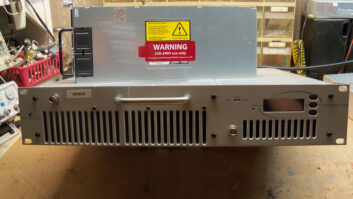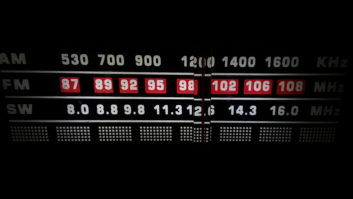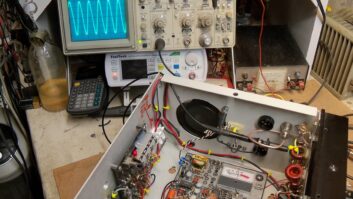(click thumbnail)Fig. 1: Designate cable and electrical runs.Good weather usually brings not only remotes but construction projects. Here are a few tips from West Virginia Radio Corp. Vice President of Engineering Noel Richardson. He and his staff have built and refurbished a number of facilities and he’ll be the first to tell you that whatever can go wrong will.
With that in mind, his first suggestion is to give yourself plenty of time. Too often engineers want to over-promise, then we under-deliver and pay the consequences. Yes, management is depending on us; but basking in the glory of a shortsighted delivery date will mean you’ll be under the magnifying glass when that date is not met. It’s not worth the stress and aggravation.
If the project will take three weeks, don’t promise that it can be done in two. Add an extra week as a cushion. This time will be absorbed by contractor delays, which always occur.
It’s not at all uncommon to begin planning for a major studio move a year or more in advance.
Not sure how long the project will take? Meet with some contractors and get some opinions. They’re usually congregated at a local 7-Eleven getting coffee in the early morning. Go talk to them. They may tell you that permits in your region are impossible to get quickly or that the good weather has them backlogged through summer.
Noel’s point is to get into “fact-finding” mode and gather as much information as possible.
Good architects who have done broadcast work should be able to provide realistic time estimates; but be conservative in any event. Even if your project is to get the transmitter building roof replaced or a parking lot re-sealed, remember that your timeframe may not line up with the contractor’s.
Noel can’t stress enough the need to plan. Review your plans and have engineering friends look them over. The object is to spot problems. What are you forgetting? What’s not going to work? There’s always something.
Planning also can be the difference between a nicely designed plant and one thrown together helter-skelter. Designate your cable and electrical runs for a neat installation. If it’s a transmitter building, keep in mind future additional capacity required for HD Radio. Also, when laying out your room, plan for both transmitter and rack door swing – something that’s easily forgotten, and not always on the transmitter layout drawing.
Thanks, Noel, for providing some good project management ideas.
* * *
Paul Sagi has engineered a number of stations in the Far East. He comments from Kuala Lumpur on our transmitter breaker discussion (March 29).
(click thumbnail)Fig. 2: An exhaust fan helps to keep your cool at the transmitter shack.
Breaker specifications, he notes, usually give trip times for various levels of current, 100 percent, 110 percent and so forth. These ratings sometimes are shown in an overload time-current graph. See if you can get a specification sheet for the breakers used at your site.
Paul brings this up because if you’ve experienced phantom breaker trips, don’t forget the temperature de-rating of the breaker. When the breaker is installed and doing its job, it’s in a panel that may have various heat sources, possibly from other wiring or breakers. A thermometer is useful to check the breaker box temperature. Several DVMs have inexpensive temperature probe accessories, and the price of stand-alone probes has dropped dramatically. Visit your Home Depot to see what’s available.
Also check the connections of the wires to the breaker, to ensure they are clean and tight. Oxidized or loose connections will cause heating that will de-rate the tripping point of the breaker. Most often, the breakers are tripped thermally, although some are tripped magnetically.
If your transmitter site has cooling problems during the summer months, adequate ventilation should be explored before the breakers – and other equipment – shut down due to the heat. A thermostatically controlled exhaust fan, as shown in Fig. 2, represents money well spent.
* * *
Paul also writes that the time has come for engineers to protect themselves. He does this with an appointment diary.
Here’s an example of how it’s used to keep you safe. Paul’s station complex had its largest (and most expensive, at a million bucks) recording studio go down at night from a UPS failure. A technician, on his own initiative, bypassed the UPS to bring the studio back into service.
Paul dealt with the UPS from the moment he arrived the following morning. He diagnosed that the control circuitry was faulty. The UPS was an older model, and no parts were available. The unit had to be replaced.
(click thumbnail)Fig. 3: Velcro brand or other reusable ‘hook and loop’ straps keep cables secure.
After passing a quote onto management, they decided they were not going to spend the money for a new UPS, saying failure was rare and the studio was OK without the UPS. Paul saw this as pennywise and pound-foolish, and made management aware of what systems were powered by that UPS. Their decision stood, the UPS was not replaced.
Months later, there was another power surge and the studio was down, long term. Companies wanting to record ads were being turned away, and the station was losing money. High-level management wanted to know what had happened.
The level of management that had refused to buy a new UPS tried to pin the blame on Paul, as though he had not been diligent in doing his job.
Paul had recorded his earlier meeting with management in his appointment diary. He was able to show the date and time of the meeting and who had said what, including the refusal to buy a new UPS.
The habit of taking notes is a great self-preservation move. I worked with an engineer who kept track of his daily work hours. Months later, a former employee went to the state employment commission about lack of overtime being paid. It turned out that a number of employees were due overtime. According to the state’s requirements, this engineer was not “exempt” from overtime and was due a healthy back paycheck, documented by his daily work diary.
Paul wrapped up his letter with a great link if you’re maintaining vintage equipment: reel-to-reels, cassette decks or VCRs. Paul has ordered rubber and cloth belts, idlers and pinch rollers from the folks at Russell Industries. This is worth bookmarking, as they are a good source for spare parts for this type of equipment. Go to www.russellind.com and click on PRB line (which stands for Projector-Recorder Belt Corp.).
The company also sells hook and loop fasteners, with both buckle and screwdown options. These straps are great for securing remote cables, as used by Bob Drazba at WILK(AM) in Wilkes-Barre, Pa., and seen in Fig. 3. The hook and loop (Velcro brand) securing method means the straps can be reused over and over.
* * *
Nick Markowitz, a contract engineer for WAVL(AM) in Apollo, Pa., and owner of Markowitz Electric Protection, a private industry fire investigation company, has stated a newsgroup with associate Al Columbo. Here you’ll find discussion of a variety of fire subjects, many of which may pertain to broadcast engineers. Visit www.tpromo.com /firenetonline. The site has interesting articles, including one by Columbo on how often to replace gel cell batteries. They don’t last forever, folks!















